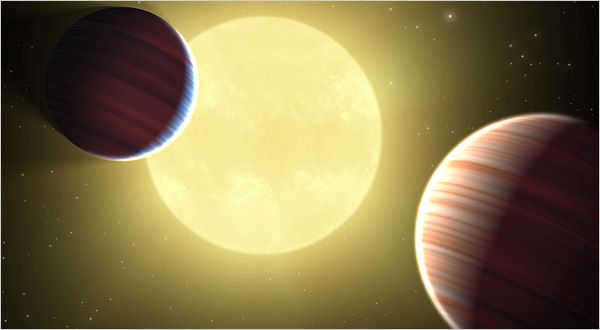We're open daily this holiday! View holiday hours
Science News
Kepler's New System
August 26, 2010

NASA announced today that the Kepler mission has found a multiple planet system about 2,000 light years from Earth.
Named Kepler 9, this new system qualifies as the first multiple system discovered by the transit method. A planet “transits” a star when it passes in front of the star, causing a drop in the star’s brightness. The length of time and amount of dimming can provide information on the transiting planet’s mass and size. Knowing the mass and size, scientists can calculate the planet’s density to determine its composition—gaseous or rocky.
Earlier this week, European scientists announced the discovery of a multiple planet system (using spectroscopy, not the transit method) with between five and seven planets. Although the sizes of five of the planets have been confirmed, their masses are unknown.
Two extraordinary findings distinguish the Kepler 9 system. Scientists have confirmed two planets are gaseous and Saturn-sized and orbit their star in a 2-1 resonance—meaning one orbits the star twice as quickly as the other. This indicates two things, according to Alycia Weinberger, from the Department of Terrestrial Magnetism at the Carnegie Institution of Washington. First, these planets most likely formed at a greater distance from the parent star and migrated in: both now lie closer to their star than Mercury does to our Sun, and eventually, the scientists hope to glean insight into the formation of the system through these two planets. Second, this resonance means that this system is a stable one, making it safer for a low mass planet (like Earth).
This leads us to the next remarkable finding in Kepler 9—an Earth-sized candidate planet! If confirmed, it will be the smallest planet observed to date. The size of the object is known, but more data is needed to confirm that it is in fact a planet. According to Bill Borucki, the Kepler Mission Science Principal Investigator, in a few more weeks they’ll be able to confirm if it’s a planet. However it might take a few years to establish whether the planet resides in the habitable zone (the sweet spot in terms of distance from the parent star, not too hot and not too cold).
He reminded all of us to be patient. Humans have been wondering for thousands of years if a planet exists like Earth. A few more years shouldn’t be too much to ask.